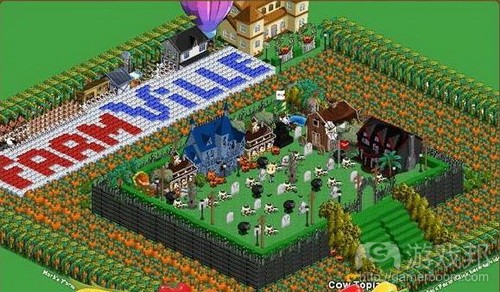推动玩家蜕变成游戏消费者的5大步骤
游戏邦注:本文作者为Matthew Warneford,文章详述促进玩家转变为付费玩家的5大步骤。
还记得第一次体验《Farmville》,当时为什么会体验这款游戏呢?是希望寻找更多途径进行在线消费吗?或者只是因为你感到很无聊?或者只是因为广告很有趣?除非你赚的钱比马克·扎克伯格多,否则应该另有原因。玩家都大同小异的:没有玩家体验《Farmville》只是因为他们希望购买更多虚拟物品,但的确有玩家为游戏掏钱。文章主要讨论如何把游戏玩家变成游戏消费者。
切记游戏并非单纯只是个游戏,它是个营销和销售过程。当有新玩家加入游戏中,他绝非仅仅是个玩家,他是个销售机会。开发商的任务就是设计能够把这些机会转变成销售机遇的游戏体验。
我们先从销售漏斗末端着手。玩家为什么会对某个游戏体验感到兴奋,愿意为之掏钱,我认为虚拟商品绝非处于马斯洛需求层次的最底部两层。然后探讨把新玩家变成忠实玩家,再变成付费玩家的步骤。
接下来我将展示实例流程。这个流程包含5个步骤,适应任何竞争刺激玩家行为的游戏(游戏邦注:这里并非指好斗运动员、饶舌歌星或大男子主义者之间的竞争,这些大男子主义者通常并非典型休闲游戏玩家),而是指攀比型的竞争。这些玩家通常会觉得好友的农场看起来比自己的美观,但他们没有时间赶上他们的进度,而且他们讨厌落后的感觉。
步骤1:适应,即学习游戏规则,享受游戏体验。我们针对那些即将离开游戏,鼠标徘徊于浏览器返回按钮的玩家。我们需要快速激起他们的兴趣,我们需要让玩家觉得自己将会擅长这款游戏,他们因此会认为游戏值得自己付出时间。为了达到这个目的,我们需要设计虚假成就感。每个玩家都希望成为赢家,体验《Frontierville》头10分钟后,Zynga就会让你觉得自己的Frontierville是最棒的!玩家所获得奖励的是同其所消耗的时间对应,而非技术等级。
步骤2:社交化,即邀请朋友,结交新朋友。如果玩家是出于攀比心理进行消费活动,我们得确保他们拥有攀比的对象!是的,如果是一款糟糕的游戏,游戏便无法为玩家提供能够分享的内容,但即便是款好游戏,也不意味着玩家会同好友分享游戏内容。开发商需要一开始就设计病毒式传播渠道(游戏邦注:我们不能期望给汽车绑上翅膀,它就能飞翔,同样地,我们不能因为在游戏中植入病毒式传播渠道,就期待其能获得发展)。
步骤3:合作,即共同体验,创建纽带。这是个微妙但很重要的步骤。玩家同好友之间的竞争比同陌生人强,所以设计合作功能能够把玩家联系在一起,为玩家提供互动理由,帮助他们成为更好的朋友。
步骤4:竞争,即炫耀。这和上个步骤紧密相联。我们必须保证游戏竞争发生在玩家能够相互炫耀的地方,双方均能够从合作中受益,并且能够清楚目睹其他玩家的表现。例如,《FrontierVille》鼓励玩家帮助清理朋友家园的树木,双方均能够从中获得金币奖励和经验积分。注意清除树木的时间并不和奖励相称,因为Zynga鼓励玩家拜访朋友的家园。帮助好友的动机越大,访问的频率就越高,访问的频率越高,他们同朋友比较进度的频率也就越高。
步骤5:转换,即消费金钱,节约时间。鉴于玩家经常同好友比较进度,我们的销售建议很简单——花钱推动游戏前进。随着前进曲线开始趋于平缓,玩家的前进步伐就开始放慢(游戏邦注:晋级因此需要消耗更长时间)。关键是把这个拐点调整至合适位置——当玩家处于高度竞争状态时,放慢游戏进程——然后为玩家提供通过付费加快游戏进程或赶上好友进度的途径。
实施上述5个步骤就能把玩家变成消费者。把这些逐一步骤落实到游戏功能和机制设计当中,循序渐进推动玩家蜕变。(本文为游戏邦/gamerboom.com编译,如需转载请联系:游戏邦)
Converting players into payers in 5 steps
By Matthew Warneford
Remember the first time you played Farmville, why did you do it? Were you looking for more ways to spend money online? Or was it because you were bored? Maybe a friend recommended the game? Or the advert just sounded fun? Unless you’ve got more money than Mark Zuckerburg, I’d bet it was one of the later reasons. Your players are no different: no-one plays Farmville because they just can’t wait to buy more virtual goods, and yet some do get their wallets out. This post is about how to convert some of your players into payers.
Remember, your game is not just a game, it’s a marketing and sales process. When a new player joins your game, he’s not just a player, he’s a sales opportunity. Your job is to design an experience that, over time, converts those opportunities into sales.
We start by thinking about the end of the sales funnel. Why will anyone get excited enough about your game to get their credit card out, because I’m pretty sure virtual goods don’t fall into the bottom two levels of Maslows hierarchy. Then figure out the steps between a new, yet to be convinced player, and one who has become excited enough to open their wallet.
I’m going to show you an example journey. It’s only five steps, and applies to any game where players are motivated by competition. I don’t mean an aggressive, athlete, rap star, alpha male kind of competition – these alpha males are not prototypical casual gamers – rather the same kind of competition that gave birth to the phase “keeping up with the Joneses”. These are the players who start to feel that their friends farm is beginning to look better than their own, but they don’t have time to catch up, and they’d hate to be left behind.
Step 1) Acclimatisation: learn the rules, begin to enjoy the game. We’re designing for the player who is about to leave and their mouse hovering over the browser back button. We’ve got to get them interested quickly, and we’ve got to make sure the player feels like they’re going to be good at the game so that they know its going to be worth spending their time. To achieve this, we design for what we call a false sense of achievement. Everyone wants to feel like a winner, after the first 10 minutes playing Frontierville, Zynga leave you feeling like the best Frontierville ever! The players reward is a function of the time they spend playing, not their skill level.
Step 2) Socialisation: invite friends and make new friends. If our players are going to spend money because they want to “keep up with the Joneses”, then we need to make sure they’ve got someone to keep up with! Yet, if its a bad game there’s nothing that you can do to convince players to tell their friends, but just because its a good game doesn’t mean they’ll tell their friends either. You have to design viral in from the very start – you can’t bolt wings onto car and expect it to fly, and likewise, you can’t bolt viral growth onto a game and expect it to grow.
Step 3) Collaboration: work together and build bonds. This is a subtle but important step. We’re more competitive with our friends than strangers, so design collaborative features that bring players together, that give your players reasons to interact, and help them become better friends.
Step 4) Competition: show off. Closely linked to the previous step. We must make sure that collaboration takes place in an area of the game where players can easily show off – both players must benefit from the collaboration, and they must both see how well the other player is doing. For example, FrontierVille encourages players to help clear trees from their friends Homestead and rewards both players with coins and experience points. Note, the time spent clearing trees is disproportionally reward because Zynga are encouraging players to visit their friends Homesteads. The greater the incentive to help their friends the more often they’ll visit their friends, and the more often they visit the more often they will compare their progress to that of their friends.
5) Conversion: spend money, save time. Now that we have players regularly judging their own progress against that of their friends our sales proposition is simple – spend money to progress faster. As the progress curve starts to flatten out players begin to progress more slowly and levelling up takes longer. The key is getting this inflection point right – slowing the game down at the point your players are sufficiently competitive – and then offering a way to pay to progress faster, or keep up with friends.
These are the five steps to convert players to payers. Use them by designing features and mechanics in your game that fulfil each step, and then build a journey that drives players through each stage. In the next post I’m going to talk about how this sales process can then be used to design and balance your games economy. What is a virtual t-shirt worth? How long should players wait between levels? How many coins should a quest reward? These are all driven by your sales process, and the steps between acclimatisation and conversion.(Source:dubitplatform)








































 闽公网安备35020302001549号
闽公网安备35020302001549号